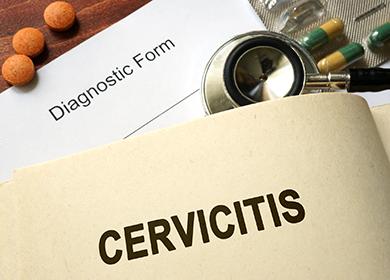The content of the article
Cervicitis, it is cervicovaginitis - some call it tsertsovit or cirvitis, but this, of course, is not true - what is it? What is the cause of this inflammation? How and how to cure it? Women begin to worry, having suspected this diagnosis and rush to the Internet to look for a photo of symptoms and medications for treatment. And not in vain.
If a woman has been diagnosed with cervicitis and especially converted to a chronic form, then she should be registered in the antenatal clinic and regularly examined. Chronic inflammation puts her at risk for joining STIs and for the development of oncology.
Why inflammation develops
The cervix is a special organ that performs a protective function. It is a mechanical barrier between the uterine cavity and the external environment. Normally, it is tightly closed, only in women giving birth, the external pharynx can pass the tip of the doctor’s finger during examination. In the neck is mucus, which also performs a protective function.
But under the influence of various pathogenic factors, inflammation develops in the neck. It can cover only the outer part, then it is called exocervicitis. If the cervical canal is involved in the process, then this is called endocervicitis.
Infection can be non-specific and specific. Moreover, its causative agents of a non-specific type are most often:
- streptococci;
- E. coli;
- staphylococci;
- bacteroids;
- corynebacteria;
- candida.
Specific inflammation is caused by:
Also, the cause may be myco- and ureaplasmas, chlamydia, trichomonads, viruses - any of the pathogens that are sexually transmitted. But most often, the activated opportunistic flora causes an inflammatory reaction.
In menopausal women, a decrease in estrogen secretion is important. This affects the condition of the epithelium of the vagina and neck and leads to atrophic cervicitis and nonspecific colpitis.
The protective function of the neck decreases under certain conditions. The most common cause of chronic cervicitis is the lack of treatment for an acute condition, which can develop in the following cases:
- cervical tears during childbirth;
- frequent diagnostic curettage;
- abortion;
- inaccurate installation or removal of the intrauterine device.
When the neck is injured, its protective function decreases, the non-specific flora ceases to be restrained. Infection freely penetrates the epithelium. The pathogenesis of neck inflammation goes through three classic stages of inflammation.
- Alteration. Damage to the epithelium occurs, part of it is desquamated and the basement membrane is exposed. With the penetration of the pathogen, the glands of the neck begin to secrete a mucous secret.
- Exudation. At this stage, the tissues loosen, special cells rush to the focus of inflammation, which should localize and destroy the pathogen. These are macrophages, histiocytes, lymphocytes, fibroblasts.
- Proliferation. Tissue regeneration occurs. In some cases, it is slow. If the ducts of the cervical glands block the new epithelium, then nabotov cysts will form, which require special treatment.This condition is called cystic cervicitis.

Symptoms of cervicitis of the cervix
Inflammation of the neck can be in acute or chronic form. Sometimes the course is initially erased and manifests itself with minimal symptoms. Signs of endocervicitis in women, as well as lesions of exocervix, are manifested in different ways.
- Acute inflammation. The discharge is abundant mucous membranes, there may be purulent cervicitis as a manifestation of gonorrhea. There is a dull pulling pain in the lower abdomen, itching in the vagina. Upon examination, the neck will be swollen, hemorrhages and small sores may be noticeable. An increase in temperature is not characteristic.
- Chronic infection. With bacterial cervicitis, the discharge is cloudy, mucous. Pseudo-erosion appears on the protruding part of the neck. Instead of the cylindrical epithelium appears flat. Swelling and signs of inflammation are less pronounced. But the inflammatory process can spread to neighboring tissues.
- Viral cervicitis. With the defeat of the herpes virus, the cervix becomes bright red, friable, similar to continuous erosion. Human papillomavirus manifested in the form of genital warts or erosion.
- Candidiasis. If a fungal infection occurs, a symptom of a “yellow granular spot” appears on the neck.
- Trichomonads. Protozoa manifest themselves as hemorrhage sites, by the outward resemblance of which the symptom was called "strawberry cervix." Atypical cells can also be found in the smear.
The cervix forms a single complex with the vagina, so inflammation often spreads to neighboring tissues. This leads to a combination of cervicitis with vaginitis, vulvitis, bartholinitis.
Necessary diagnostics
The erased course of cervicitis often does not allow for timely diagnosis. Sometimes the disease is detected in the chronic stage during a routine examination. The main goal of diagnosis is to find the true causes of inflammation. To do this, use the following methods.
- Inspection. A mandatory step in the diagnosis of gynecological pathologies. Visually, the doctor evaluates the condition of the neck, the severity of inflammation, the presence and nature of the discharge, erosion, ulceration, cysts.
- Colposcopy. The method allows you to accurately examine pathological foci on the neck, as well as using special tests to diagnose some diseases. During colposcopy, a tissue site can be taken from suspicious foci for histological examination.
- Smear. Microscopic examination is carried out to establish the nature of microflora. You can also find various epithelial cells and identify their degree of atypia.
- Bakposev. The method is aimed at identifying flora, determining its sensitivity to antibiotics. For analysis, a vaginal discharge is taken.
- PCR. It is not possible to use seeding methods for viruses. They need cell cultures on which the growth of the pathogen takes too long. Therefore, PCR analysis is used, which detects the DNA of viruses in the test material. In the same way they diagnose chlamydia, mycoplasmosis.

How to get rid of the disease
The treatment regimen for acute cervicitis depends on the type of pathogen that provoked the inflammation. If the cause is a sexually transmitted infection, then simultaneous treatment of sexual partners is necessary. Sex during therapy, regardless of the cause, is prohibited.
- Bacterial infection. Be sure to prescribe antibiotics depending on the sensitivity of the microorganism. Chlamydia also requires treatment "Doxycycline"," Erythromycin ","Azithromycin».
- Fungal cervicitis. Treatment is carried out with antimycotic drugs. More effective use inside "Fluconazole." Butoconazole in the form of Ginofort cream is prescribed locally. In chronic course and frequent exacerbations, antirecurrent treatment is required for six months.
- Viral lesions. Very difficult to treat. When infected with herpes, HPV is completely impossible to get rid of the pathogen. It is stored in the nuclei of cells, which allows the virus to evade immune surveillance. For treatment, apply "Acyclovir"," Valacyclovir. " A special vaccine has been developed to prevent the recurrence of herpes. For papillomavirus infection, suppositories with interferon are prescribed, papillomas are cauterized.
- Atrophic cervicitis. The cause of the pathology is a lack of estrogen, so if there is no need for hormone replacement therapy, then local estrogen preparations are prescribed in the form of cream, suppositories. The course of treatment in this case is long.
How to properly treat exocervicitis, only a doctor can say. Very often, the infection occurs as a microbial association. Then combined treatment is required. With a combination of candidiasis and non-specific bacterial pathogens, candles "Polygynax" or "Terzhinan". They contain antibiotics and an antifungal component, which allows you to act on all pathogens at the same time. Interruption of treatment during menstruation is not required.
At home, many seek to use folk remedies, especially when there is no way to get to the doctor. In the arsenal of traditional medicine there are no antibacterial agents. Most herbs and plants used have anti-inflammatory properties. And they do not directly affect the infection. Therefore, such treatment can translate the disease into a chronic form.
Reviews of women about various methods of therapy are diverse. For some, timely medical care brought quick relief, and in some cases the treatment for cervical inflammation dragged on. So that the process does not take long months, you should fully comply with the doctor’s recommendations and do not change the dose of medication yourself.
Reviews
I got cervicitis. I went with suspicion tothrush. The thrush also appeared, but C. was diagnosed at the same time. G. said that everything around the cervical canal is on fire. But since I’m in the GV, I’m not allowed many repertoires. I am being treated for thrush while Pimafucin (with tablets and candles) and Ekofemin, G. said - that C. can pass.
Alegria https://www.cosmo.ru/forumn/topic/180764-%D1%86%D0%B5%D1%80%D0%B2%D0%B8%D1%86%D0%B8%D1%82/
I got cervicitis andendometritis. The treatment is similar to yours: Metronidazole, Terzhinan, Ofloxocin, Klacid was, right now, neo-penotral and vaginorm were prescribed.
I got positive results after 3 weeks of treatment. And the doctor said the same when examined. My G also told me that the reason is either an STI, or dysbiosis, etc. Like he doesn’t get out from a cold. But I have ureaplasma, apparently because of her.NataliaSun, https://www.cosmo.ru/forumn/topic/180764-%D1%86%D0%B5%D1%80%D0%B2%D0%B8%D1%86%D0%B8%D1%82/
Was on colposcopy of the cervix - post-traumatic erosion was placed there (after childbirth). It turns out that cervicitis is nonspecific. Antimicrobial and local anti-inflammatory treatments are prescribed. Let's see ... But because I'm being prepared for surgery (ovarian cyst), they said that they would thoroughly deal with this after the operation, because "Ovary is more important to save." And I would like to treat this in parallel.
Mom Gugunov, https://rebenok.by/community/index.php?topic=147722.0

